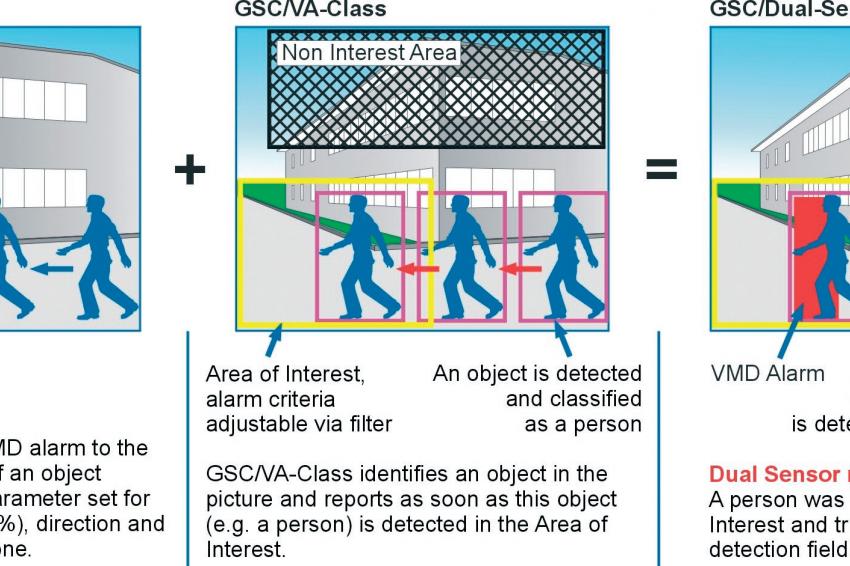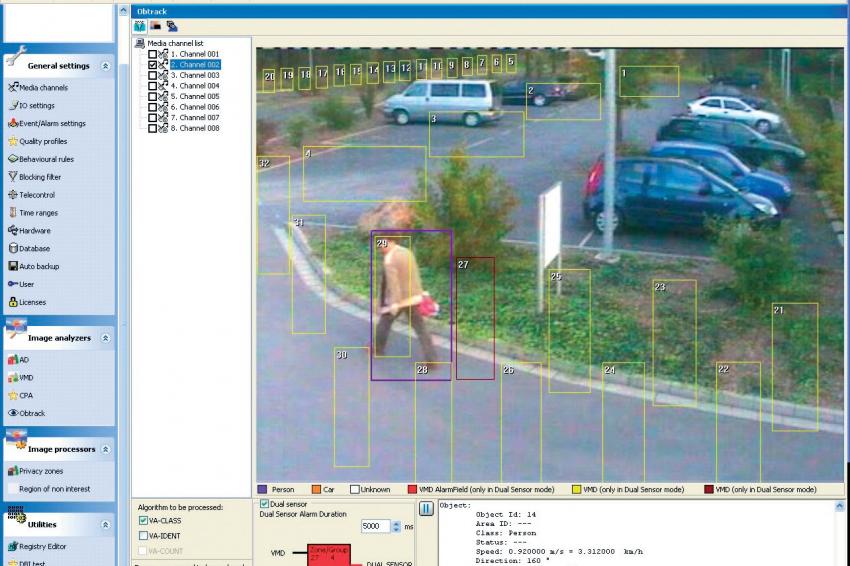Geutebrück: video detector with altogether better accuracy and reliability
08.08.2012 - Geutebrück: video detector with altogether better accuracy and reliability. Constantly striving to replicate the analytical skills of the human eye and brain, developers are always...
Geutebrück: video detector with altogether better accuracy and reliability. Constantly striving to replicate the analytical skills of the human eye and brain, developers are always looking for new ways to improve the reliability and accuracy of video detection systems. One new strategy is to apply the logic that two heads are better than one and combine video motion detection with the emerging software technology of video analytics. The result is a new class of detector which applies the strengths of both to identify threats more accurately and to eliminate more unwanted alarms.
Video motion detectors have been around for many years. High end models have a proven track record in securing extensive and high security sites: prisons, power plants, airports, defence establishments and the like. They are extremely efficient at detecting movement in specified zones and very good at eliminating the effects of global environmental changes such as those caused by weather or mast movement. Video analytics on the other hand is a relatively new technology enabled by the growth in computer processing power. Its forte is recognising different kinds of specified objects in a video scene. To understand why it makes sense to use them together, let us first focus on the differences between the two systems.
Video Motion Detectors
Video motion detectors (VDM) detect and report motion in predefined areas of a camera image. They work by analysing the composite video signal from the CCTV camera, or to be more precise, they analyse an electrical representation of the instantaneous grey shades in the picture and monitor this for changes in brightness or contrast. In a picture from a fixed camera and in an environment with fixed illumination, this change can logically be deduced to be the result of activity in the scene.
However, a VMD designed for outdoor situations where light levels and other conditions vary widely has to have a few important extra sophistications which eliminate benign environmental changes while enabling the detection of potential threats. First, its sensitivity has to be very high to enable it to detect low contrast intruders in front of equally low contrast backgrounds, and to be able to analyse each individual detection zone in the scene for the subtle differences caused by environmental changes.
Comparing results across the whole image is what enables the VMD to deduce which changes are global, and therefore benign, and which are localised and more likely to represent a hazard. Second, the VMD has to compare and store information from successive images from the same camera fast enough to ensure that a fast-moving target is captured within the operating cycle while it passes across the scene. And thirdly, the VMD has to enable the user to set up small detection zones in the far field which are much more sensitive than those in the near field.
This is to counterbalance the fact that any target naturally appears larger, and causes more signal disturbance when it is near the camera, than when it is far away.
Video Analytics
Video analytics is the technology of using intelligent software to filter and manage real-time CCTV video. Here it is the pixels in the whole video picture which are analysed. The software continuously analyses the scene and deduces for itself the basic underlying model, then constantly updates it for global changes such as weather and lighting. Current pictures are continuously compared with the updated background model and any unnatural changes are compared with the user’s target specification.
The user can specify the target objects by their likely size, speed, direction of movement and status, and he can link their properties. The system can recognise ‘person’, ‘car’, ‘fast’, ‘slow’, ‘wrong direction’, ‘object appearing’ and ‘object disappearing’, separately, or only when logically combined with each other. This enables the system to trigger alerts when a person moves fast, or a car goes in the wrong direction, but to ignore a car going fast or a person going in the wrong direction. The user can also define different areas of interest in the scene and associate them with different target characteristics and alarm response behaviours.
Separate but Together
When both detection systems are run independently to monitor the same scene, their output can be logically combined so that an alarm is only passed on to the operator when the precise pre-determined criteria for both systems are met at the same time. This means for instance that a bird which might trigger a VMD alarm because it meets the system’s movement and location criteria, would not match the VA’s specific size threat criteria, so no combined system alarm would be issued. And, on the other hand, when the wind deflects the leaves in a shrubbery and deceives the VA into registering the shape of a person or a car the VMD does not react so no alarm is reported.
Working together the systems’ strengths are exploited and their weaknesses reduced. Each system alone would produce a small, but (possibly highly) undesirable number of unwanted alarms. But with two finely-tuned, compatible systems running in tandem, then it is possible to get very, very close to the ideal situation of no unwanted alarms.
First Commercial Application
As yet (so far as is known) the only dual mode detector available in the market is Geutebruck’s Dual-Sensor which has been developed for outdoor detection in difficult environments. It runs on the GeViscope CCTV platform and allows its VA software and the GeViscope’s built-in VMD to run completely separately or in tandem, so the user has the flexibility to match his use of the system to the monitored scene.
Contact:
Geutebrück GmbH,
Windhagen, Germany
Tel.: +49 2645 137 0
Fax: +49 2645 137 239
info@geutebrueck.de
www.geutebrueck.com










